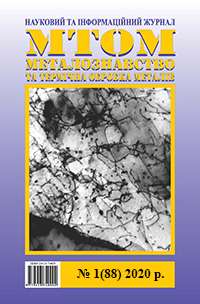THE BEHAVIOUR OF HETEROPHASE INCLUSIONS “PHASES ARE BESIDE” UNDER STEEL PRESSURE FORMING
DOI:
https://doi.org/10.30838/J.PMHTM.2413.260222.36.630Keywords:
steel, heterophase nonmetallic inclusions “phases are beside”, pressure formingAbstract
Purpose. The technological ductility of steels is largely determined by the behavior of non-metallic inclusions at different deformation temperatures. The aim of the work was to study the shape change of heterophase inclusions of the “phases are beside” under different conditions of steel processing by pressure. Methods. Identification of inclusions of the “phases are beside” before and after deformation according to different modes was carried out by several methods: metallographic, petrographic, X-ray spectral analysis. Results. It has been established that the phase-mineralogical composition of the heterophase inclusions of the “phases are beside” determines the processes of their change under hot and cold deformation. The level of plasticity of the phases of inclusions determines the nature of their interaction between themselves and the steel matrix during their joint deformation. A different combination of phases in the inclusions of the “phases are beside” implies a different shape change of the inclusion as a whole during hot or cold rolling of steels. Scientific novelty. The shape-changing features of heterophase inclusions of the “phases are beside” during hot and cold deformation were established. The important role of interfacial friction processes was shown, which develops on sections of the inclusion-matrix boundaries (with different inclusion phases) and on the internal boundaries in inclusions whose phases have different plasticity. It was shown that the character of the shape change of the“phases are beside” inclusions is determined by the mutual influence of inclusions phases on their joint deformation. The possibility of transforming the inclusion of “phases are beside” in the process of hot and cold deformation when machining steel with a vice is shown. Practical significance. The obtained results of the study dedicated to features formation of heterophasic inclusions of the “phases are beside” can be used in the development of technologies for producing steels with the regulated content of heterophase non-metallic inclusions, including the type of “phases are beside”. These results contribute to solving important problems associated with improving the technological ductility of steels for various purposes, as well as preventing the formation of defects during the processing of steels by pressure.
References
Vinograd M.I. and Gromova G.P. Vkluchenia v legirovannih staliah I splavah [Inclusions in alloy steels and alloys]. Moscow : Metallurgy, 1972, 216 p. (in Russian).
Gubenko S.I. Nemetallicheskiye vklyucheniya i plastichnost' staley [Non-metallic inclusions and ductility of steels. The physical basis of the ductility of steels]. Saarbrücken : LAP LAMBERT. Palmarium academic publishing, 2016, 549 p. (in Russian).
Belchenko G.I. and Gubenko S.I. Deformatsiya nemetallicheskikh vklyucheniy pri prokatke stali. [Deformation of non-metallic inclusions during steel rolling]. Izvestiya AN SSSR. Metally [News of the USSR Academy of Sciences. Metals]. 1983, no. 4, pp. 80−84. (in Russian).
Gubenko S.I., Bespalko V.N. and Zhilenkova Ye.V. Vliyaniye temperatury i stepeni deformatsii na kharakter izmeneniya evtekticheskikh boridov v vysokokhromistoy stali s borom [Influence of temperature and degree of deformation on the nature of changes in eutectic borides in high-chromium steel with boron]. Teoriya i praktika metallurgii [Theory and practice of metallurgy]. 2006, no. 4−5, pp. 158−160. (in Russian).
Gubenko S.I. Mezhphaznie granitsi vkluchenie − matritsa I svoisrva stalej [Interphase boundaries inclusionmatrix and properties of steels]. Germany − Mauritius : Palmarium academic publishing, 2017, 506 p. (in Russian).
Kiessling R. and Lange N. Nemetallicheskie vkluchenija v stali [Non-metallic inclusions in steel]. Moscow : Metallurgy Publ., 1968, 124 p. (in Russian).
Gubenko S.I. and Bespalko V.N. Vidy i struktura geterofaznykh vklyucheniy v stalyakh [Types and structure of heterophase inclusions in steels]. Metal Science and Heat Treatment of Metals. 2019, no. 1 (84), pp. 30−35. (in Russian).
Gubenko S. Geterofaznyke mikrokompozitnyye vklyucheniya v stalyakh. [Heterophase microcomposite inclusions in steels]. Germany − Mauritius, Beau Bassin, Palmarium academic publishing, 2019, 330 p. (in Russian).
Gubenko S.I. Nemetallicheskie vkluchenija i prochnost stali [Non-metallic inclusions and strength of steel]. Saarbrücken : LAP LAMBERT. Palmarium academic publishing, 2015, 476 p. (in Russian).
Gubenko S.I. Fizika razrusheniya staley vblizi nemetallicheskikh vklyucheniy. [Physics of steel fracture near non-metallic inclusions]. Dnipropetrovsk : NMetAU, Information Technology Systems Technologies, 2014, 301 p. (in Russian).
Gubenko S.I. and Iskov M.V. K voprosu o stroyenii mezhfaznykh granits nemetallicheskoye vklyucheniye-matritsa v stali [the question of the structure of interphase boundaries non-metallic inclusion-matrix in steel]. Teoriya i praktika metallurgii [Theory and Practice of Metallurgy]. 2004, no. 5, pp. 30−38. (in Russian).
Gubenko S.I. K voprosu o stroyenii mezhfaznykh granits nemetallicheskoye vklyucheniye-matritsa v stali [To the question of the structure of interphase boundaries non-metallic inclusion-matrix in steel]. Izvestiya AN SSSR. Metally [News of the USSR Academy of Sciences. Metals]. 1994, no. 6, pp. 105−112. (in Russian).
Gubenko S.I. and Parusov E.V. Plastichnost' splavov s razlichnoy strukturoy. Uchebnoye posobiye po fizicheskim osnovam plastichnosti [Plasticity of alloys with various structures. Study Guide on the Physical Basics of Plasticity]. Germany − Mauritius, Beau Bassin, Palmarium academic publishing, 2017, 185 p. (in Russian).
Downloads
Published
Issue
Section
License
Authors that are published in this journal agree to follow the conditions:
Authors reserve the right to the authorship of his work and cede the right to the journal of first publication of this work on conditions of the license under the Creative Commons Attribution License, which allows others to distribute it freely with the obligatory reference to the author of the original work and the first publication of the work in this journal.

